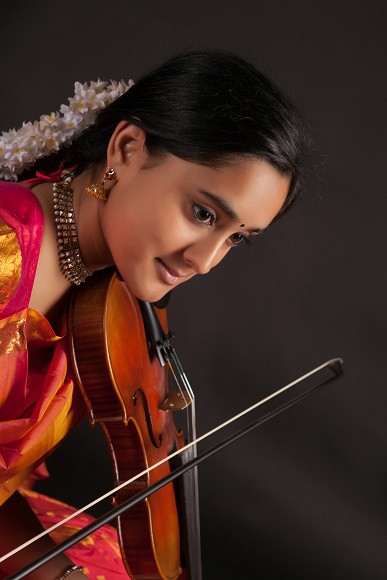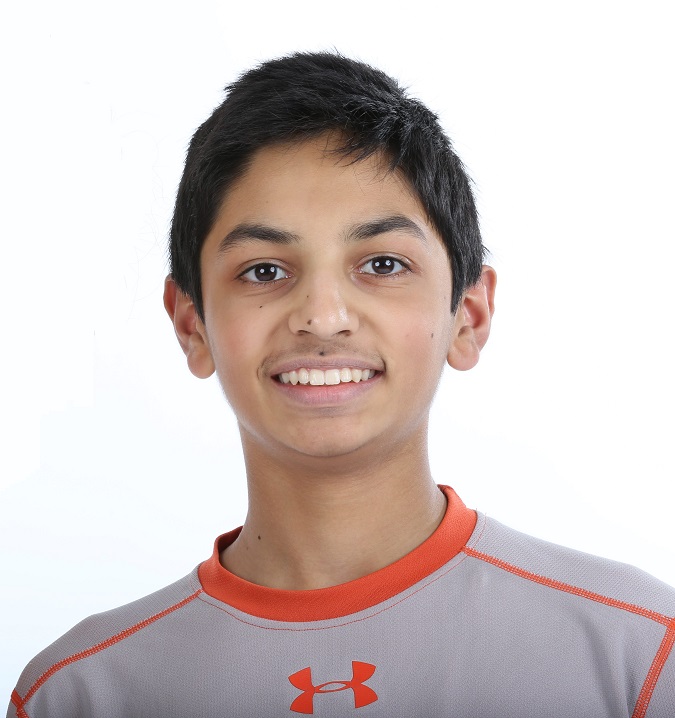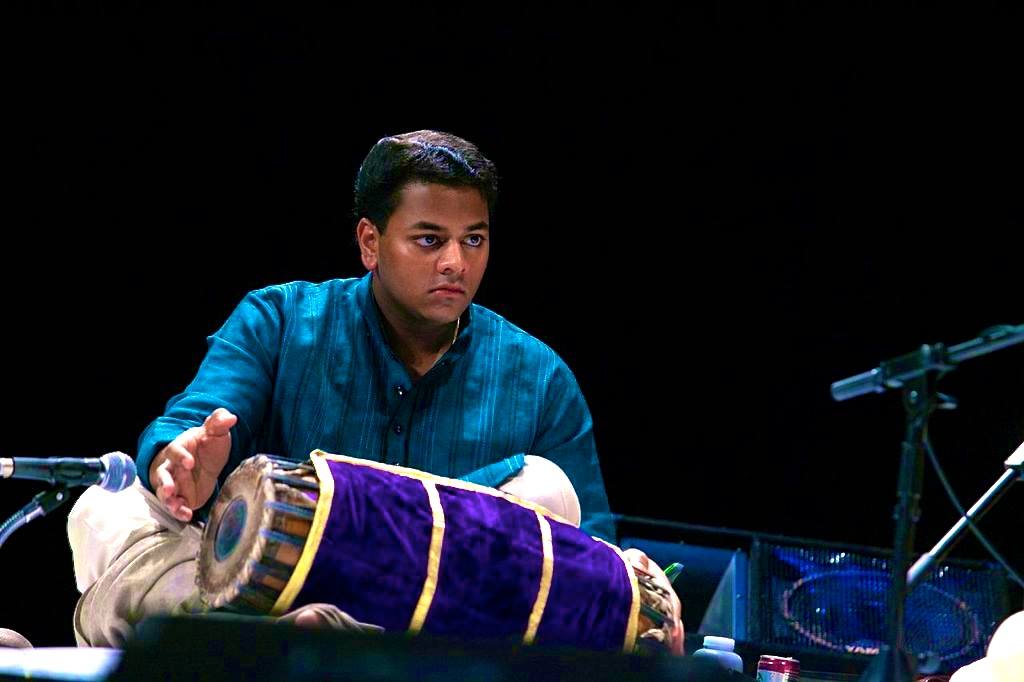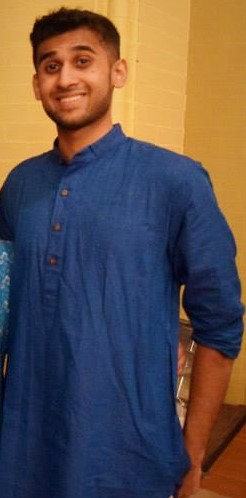Contribute
| KHMC Hosts Carnatic Concert |
Vasu Kandadi
07/08/2015
June 20th, 2015, marked a memorable day when several Carnatic rasikas of the Boston area stood witness to a beautiful concert that undoubtedly left an indelible reminder that Carnatic music is alive and well among the next generation of artists and among the local community at large. The concert was graciously arranged by KHMC, an excellent organization that promotes Carnatic and Hindustani music by providing local artists a forum to present their skills to the community while enabling access to the music to a wide cross-section of the rasika community.
The evening started out with people shuffling in, excited to support the young artists that were to perform and it was evident that everyone in the room was just happy to see that this ancient art form is being embraced by the next generation of artists in an entirely different continent than the one where the art form originated. What followed, however, was nothing short of greatness. Everyone in the room was treated to what was essentially a full blown concert, the kind one would pay good money to get front row seats in, except that everyone seemed to have front row seats.
The concert started with a beautiful varnam in ragam Shanmukhapriya, “Ilaloâ€, set to adi talam with the alaapana rendered with excellent control and precision by Srivatsan Raghavan. “Namaami†in ragam Hamsadhwani, set to adi talam (tisra nadai) with a wonderful alaapana rendered by Sudarshan Thirumalai made the audience sit up and take notice of what the potential for the evening was. An interesting choice for an evening concert, Sadhachale in ragam Bhoopalam, a morning ragam, set to adi talam, was performed next with flourish with an alaapana rendered beautifully by Pratik Bharadwaj. It was woven with such complex patterns, yet with apparent ease, that the people in the audience were convinced that they were in for a special evening performance.
Then came “Pankaja Lochana†in ragam Kalyani set to misra chapu talam. The alaapana performed by all the artists with brilliant support from Sahana Srinivasan on the violin was enjoyable, not just for the audience but also for the artists whose seemed to feed off of each other and enjoy each other’s playful, yet graceful twists. The violinist seemed to transform her style to match the vocalist who she was accompanying at that time. The thani avarthanam by the percussionist, Tarun Bangalore, showcased his talent and expertise. The energy he brought to the room was palpable with everyone in the room trying their hand at the misra chapu talam. His command over the instrument was evident from his execution of complex rhythmic patterns with a level of ease and joy that seemed more like a conversation between him and his closest friend, the mridangam. “Sripathe nee pada†in ragam Nagaswaravali set to adi talam was performed next with ease and without too many embellishments setting the stage for the center piece presentation.
The RTP in ragam Thodi started with a wonderful sequence of alaapanas by each vocalist. Each one seemed to have a unique style emphasizing the use of different gamakas, octaves and tempos that is afforded by a beautifully complex ragam such as Thodi. Yet, they seemed to be connected by a seemingly engaging Carnatic conversation. The volleys of alaapana strung by the vocalists culminating in a fantastic gentle finish provided the perfect platform for a solo piece by the violinist, Sahana Srinivasan. And oh what a piece it turned out to be! The alaapana by Sahana started by giving some hints of the prayogas that are yet to come and quickly reached a stable base. The feeling that most in the audience likely felt, is one you get when you have been going up a roller coaster at a steady pace seeing parts of the ride ahead of you and you feel the chain let go and you are ready for the ride ahead. The audience was treated to an intricate weave of the beautiful ragam with wonderful gamakas that seemed to sway everyone in the room in unison. The performance was deliberately constructed to start with simple yet melodious patterns and progressed to longer and more complex prayogas, building up to a crescendo and an equally graceful progression to a sweet finish. The people in the room seemed to have momentarily forgotten that this was just a solo piece in a vocal concert and were only reminded of it when the vocalists picked up where the violinist wrapped up her piece. The taanam was performed with equal aplomb by each of the artists and the addition of percussion, albeit unusual, seemed to brighten the mood in the room, not that it needed much to start with. The playful end of the tanam between Pratik and Sahana leading into the slow and deliberate finish typical of a tanam’s end by all the artists was particularly enjoyable. The pallavi, “Amba … Jagadamba … Karunimpa … Samayamidhe …†set to mishra jaathi thriputa talam in thisra nada was a fabulous display of rhythm and melody where every variation of the palllavi seemed to set the platform for the next variation to be built on top of. The ragamaalika kalpana swarams by each artist at two different speeds were extremely well constructed, in ragams Darbari Kaanada, Hameer Kalyani, Begada, Kiravani in first speed and in ragams Nattaikurunji, Ranjani, Naganandhini and Revathy in second speed. The ending of the pallavi in Darbaari Kaanada during kalpanaswaram rendered by Srivatsan, ended in Rishabham (when it seemed like everyone expected to end in a calming Shadjamam) drew a spontaneous applause from the audience. The Begada kalpanaswaram was also brilliantly rendered with the necessary exaggerated asiavus of Madhyamam and Nishadam.
After the intense, yet enjoyable, performance of the RTP hunting crossbow, the mood of the concert lightened dramatically as the artists presented the thukada piece “Narahari deva†in ragam Yamuna Kalyani set to adi talam leading into a beautiful Thillana in ragam Khamas. By this point, the audience knew for sure that they had just witnessed a special concert and instead of only feeling good having supported the local young artists, they felt a distinct sense of pride in being part of the special performance. The audience seemed to be torn between wanting the concert to go on as long as possible and wanting to end it without any sign of imperfection entering into the spectacular evening. When the customary mangalam in ragam Sowrashtram was sung the room was replete with a sense of relief, satisfaction, pride and undoubtedly some disappointment that it had to end.
It would be a travesty, if we did not acknowledge the contributions of the guru of the vocalists and violinist, Smt. Tara Anand and the percussionist’s gurus Dr. Pravin Sitaraman and Sri Jayachandra Rao in transforming a set of talented and driven kids into consummate performers all for the benefit of the rasika community of the Boston area and elsewhere. If this concert was any indication of things to come, it is clear that the next generation has stepped up to the plate in grand style to pick up this beautiful art form and carry it forward and would hopefully pass it on to the next.
You may also access this article through our web-site http://www.lokvani.com/



